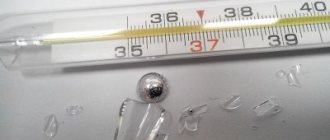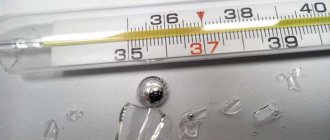Demercurization
Demercurization with bleach
1.
Prepare a bleach solution containing chlorine in a plastic container. The solution should be made at the rate of 1 tablespoon per 5 liters of water.
2.
Using a sponge or cloth, treat the area of contamination, including all crevices. After 15 minutes, rinse the solution with water.
3.
Do not throw away the used sponge or rag, but hand it over to specialized enterprises.
4.
Over the next 2-3 weeks, you need to regularly wash the floor with a chlorine-containing solution.
5.
It is advisable to keep the window ajar for a long time.
Demercurization with potassium permanganate
When treating the surface with a solution of potassium permanganate, pay special attention to cracks and crevices where mercury particles may “lurk.” You can even pour the solution into the cracks.
1.
Prepare a solution of potassium permanganate so that it is dark brown in color and almost opaque.
2.
Add 1 tbsp to the solution. l. salt and 1 tbsp. l. vinegar essence (you can replace it with a pinch of citric acid, or 1 tbsp. rust preventative).
3.
Using a brush or brush, treat the area of contamination, including all crevices.
4.
Leave the solution on the surface for 1-2 hours. If the solution dries out at this time, moisten the area with water.
5.
It is worth noting that the solution may leave stains that are difficult to remove.
6.
Prepare a soap-soda solution at the rate of 40 grams of grated soap and 50 grams of soda per 1 liter of water and treat the stained area with it.
7.
Over the next few days, this procedure must be repeated regularly, while the potassium permanganate solution is kept for less time.
8.
Do not forget to regularly carry out wet cleaning and ventilate the room.
Demercurization using potassium permanganate (potassium permanganate) and soap solution
You can apply two cleaning methods in turn at once:
1.
To begin, prepare a 0.2% aqueous solution of potassium permanganate, i.e. dilute 20 g per bucket of water. It will be even better if you add hydrochloric acid to this solution. Use a brush, brush, and spray bottle to treat the area where the thermometer broke.
2.
After 1 hour, wash the treated area using a solution of soap and soda (4% soap in a 5% aqueous soda solution).
3.
This cleaning should be repeated 3 times a day.
4.
Take all collected thermometer waste to a facility that is authorized to dispose of mercury and its waste, or call a specialized service to pick up the waste.
It's broken after all
Let's figure out what happens if a mercury thermometer breaks, what consequences will follow.
When the “living metal” is exposed to air, it gathers into balls. Those, in turn, can roll into the far corner and penetrate the gap. They will slowly and surely poison the body with evaporating toxins.
You should know it! Mercury evaporation occurs at 180C. Toxins enter through the lungs. In large quantities, poisoning can even occur through the skin and mucous membranes. The danger comes from broken glass, which can cause injury.
Interesting! The mercury mineral that gets into the stomach will not cause harm to health. It is eliminated from the body through the intestines. It is practically not absorbed into the blood.
If your thermometer breaks at home. What to do after demercurization?
- O
Call the Ministry of Emergency Situations by calling 101 or 112 from your mobile phone to give them a jar of mercury.
- create a draft - intense air flow will prevent the concentration of mercury vapor
- wash your shoes with potassium permanganate and/or soap and soda solution
— it is advisable to completely dispose of the gloves using the above recommendations
- rinse your mouth and throat with a light solution of potassium permanganate (light pink color)
- brush your teeth well
- take activated carbon (2-3 tablets)
— drinking plenty of fluids (tea, juice) will help remove possible mercury formations from the kidneys.
If you think that not everything has been removed and mercury is still present in the room, call specialists who have a mercury gas analyzer. To take the necessary measurements, contact your local hygiene and epidemiology centers.
Capital reception points
Not all enterprises that utilize mercury do not carry out demercurization, that is, removal of mercury from residential premises. In this regard, it is necessary to find a company that will pick up the broken device and demercurize the premises.
EKO-Expert is a metropolitan enterprise that is engaged in the recycling and cleaning of hazardous metals from premises. The company has a license for this type of activity, and its employees are professionals with chemical education.
In addition, there are a number of metropolitan enterprises that accept mercury measuring devices for disposal:
- Fire center, which operates around the clock;
- Research and production enterprise "Ekotrom";
- State corporations "Ecorecycle" and "Waste Management".
What not to do if a mercury thermometer breaks
1. Never wash items, clothing or shoes that have come into contact with mercury. Better just recycle these things
.
2. Don't use a vacuum cleaner
to collect mercury, since the air it blows and heats increases the rate of mercury evaporation. In addition, this liquid metal, if it gets into the vacuum cleaner, lingers inside on the parts, which makes the vacuum cleaner a tool for distributing toxic mercury, which means that the vacuum cleaner must be disposed of.
Even if you use the most modern vacuum cleaner, with improved filters that can trap mercury, some of it will still settle in the corrugated hose. This means that the hose will have to be processed as indicated above, which is not so simple.
3.
Do not create a draft before removing the mercury.
4.
Do not throw a broken thermometer into the garbage chute - just 2 grams of evaporated mercury is enough to contaminate 6000 cubic meters. m.
5.
Do not collect mercury with a broom - its hard rods can crush mercury balls and scatter them over an even larger area.
6.
If mercury gets on a sofa or carpet, do not throw it away. It is also worth noting that dry cleaning is not the best solution.
— The carpet needs to be rolled up from the edges to the center to prevent the mercury balls from scattering.
- After this, prepare a plastic bag or film and wrap it in the carpet or covering that has come into contact with mercury. You also need to wrap from the edges to the center.
— Put the carpet on the balcony, garage or outside.
You also can:
* Give your item to an organization that specializes in collecting mercury-containing waste.
* Call demercurization specialists to remove the mercury.
6.
Do not wash clothes that have been exposed to mercury. It is better to render it unusable so that no one will wear it.
Better yet, pack such clothes, along with rags and other materials that have been in contact with mercury, in a thick plastic bag and hand them over to an organization that collects waste that contains mercury.
7.
Do not throw mercury down the drain, where it can settle and release harmful fumes and be very difficult to remove from the drain.
Golden rules
- It is prohibited to dispose of the thermometer with household waste.
- Do not sweep or collect mercury balls with a vacuum cleaner. Dangerous vapors remain on the brooms and inside the vacuum cleaner; they cannot be used after such cleaning.
- Do not flush hazardous metal down the toilet.
- You cannot wash clothes in the machine that were worn by the person who removed the mercury. It is best to throw these clothes away.
- Give the thermometer in a glass container with a very tightly closed lid.
What is mercury poisoning
Symptoms of chronic poisoning appear several years after the body comes into contact with mercury, so it is better not to let this happen and strictly follow all the instructions in this article.
Evaporating, mercury poisons the air indoors and, if you regularly breathe this poisoned air, mercury will begin to accumulate in the human body, namely in the kidneys, liver and brain, after which chronic mercury intoxication
.
Such intoxication can be manifested by symptoms such as dermatitis, stomatitis, salivation, metallic taste in the mouth, diarrhea, headaches and dejection. In addition, mercury intoxication leads to kidney damage
, as well as trembling in the arms, legs and whole body.
It is worth noting that mercury, or more precisely its vapors, primarily affects the nervous system!
Poisoning can occur without any symptoms for a long time
.
The first thing that may occur to someone who has been poisoned by mercury vapor is irritability, accompanied by nausea
.
A person may think that his condition is due to fatigue at work or other similar reasons. But at this time the poisoning quietly creeps up to your central nervous system and kidneys
.
Mercury poisoning can occur, and symptoms of chronic poisoning may occur after several months.
, and even in some cases years. This applies to rooms where the air is poisoned by mercury vapor that does not greatly exceed the norm.
Health effects
Once in the body, mercury vapor attacks the central nervous system, kidneys, gums, and provokes deformation of organs and tissues. Just one broken thermometer can cause harm to the health of all family members.
Factors influencing the degree of poisoning:
- duration of exposure;
- state of the immune system.
Children and women in an interesting position are more vulnerable.
From all of the above, the question arises - how to reassemble a broken mercury thermometer so that it does not harm anyone.
Pros of a mercury thermometer
- it more accurately measures the temperature of the human body, and its readings can be compared with those of a gas thermometer, which is considered a reference thermometer.
- such a thermometer is less susceptible to extraneous factors and temperature fluctuations than its “colleagues”.
— by placing a mercury thermometer in a disinfectant solution, you can quickly disinfect it, which cannot be said about other types of thermometers.
- this thermometer is inexpensive when compared with electronic versions, and at the same time it is quite difficult to manufacture, because it requires mercury of special purification and fairly high quality. This fact gradually leads to the fact that there are fewer mercury thermometers, and more electronic ones, and with constant progress in the field of high technology, electronic thermometers will fall in price and become more attractive to buyers.
- A mercury thermometer is very easy to use.
Maybe it's time to get rid of the mercury in the house?
Get rid of mercury in your home
The fact that mercury thermometers are dangerous has been recognized in the EU and in a number of other countries. That is why the use of mercury thermometers is prohibited in medical and healthcare institutions. At the same time, the sale of measuring instruments containing mercury, including thermometers and thermometers, is prohibited. This measure can significantly reduce the amount of toxic mercury entering the environment with household waste.
Electronic thermometers are the best alternative to mercury thermometers. Since there is no mercury or glass in their body, they are absolutely safe to use for humans, including when measuring in the mouth. And the speed of measurement and the presence of memory distinguishes them favorably from the old mercury thermometer./p>
Recycling points
Moscow is the capital of our Motherland, so there is a collection point for damaged thermometers and more than one.
However, there are specialized collection points for mercury thermometers in other large cities of Russia:
- In the northern capital, the city of St. Petersburg, recycling is carried out by a company located on Volkhonskoye Highway.
- Industrial Waste Safety Center LLC is an Ekaterinburg recycling company located on Pushkin Street.
- The Chelyabinsk enterprise "Shield" is located on Mekhanicheskaya Street.
- “Ecological Perspective” in Perm is located on Reshetnikovsky Spusk.
- Arkhangelsk LLC "TECH-service" is located on the street of the 50th anniversary of October.
- The civil defense enterprise in Irkutsk is located on Tchaikovsky Street.
- The environmental center in the city of Vladivostok is located on Irtyshskaya Street.
- in Kazan is located on Adel Kutuya Street.
- Omsk University of Environmental Problems is located on 5th Kordnaya Street.
If the locality does not have a specialized collection point for damaged thermometers, then the device can be handed over to the sanitary-epidemiological service or a medical institution.
What consequences are possible if the thermometer is damaged?
Mercury belongs to the first toxicity class poisons. This means that once the substance enters the body, the dangerous consequences are irreversible.
Mercury itself is practically not dangerous, but since it is the only metal that remains in liquid form under room conditions, its vapors and inorganic compounds (sublimate, calomel, mercuric cyanide) are dangerous. It evaporates at a temperature of +18 degrees, and the rate of its evaporation is 10,000 times less than the rate of evaporation of water.
A regular thermometer contains 1–2 grams of mercury. This is enough to poison all family members in the room where the thermometer broke. The danger also lies in the fact that the small balls are very mobile. They can scatter on the floor and roll into hard-to-reach places, from where they will evaporate for ten years, poisoning everyone around.
Please note that mercury can accumulate in the body. This means that if a substance sufficient to cause poisoning is ingested, symptoms may not appear immediately.
In what cases should you call specialists?
The Ministry of Emergency Situations on its official website gives detailed recommendations for the collection of mercury in residential premises. Immediately after the thermometer has broken, it is better to call the rescue service at 101 or 112 and consult with a representative of the Ministry of Emergency Situations on this issue.
Unfortunately, in Russia there is no well-functioning system for organizing the collection and disposal of mercury. In some cases, representatives of the SES and the Ministry of Emergency Situations do not even go to the scene of the incident, and give recommendations for collecting mercury over the phone. If employees refuse to respond to a call, contact a higher authority and ask for help. If you do not get a team to come out, collect the mercury yourself and take it to a radioactive waste collection point.
In megacities, there are often private companies that collect and dispose of the remains of broken thermometers and mercury. They also check the air for fumes. However, since these firms are private, you will have to pay to call a specialist.











